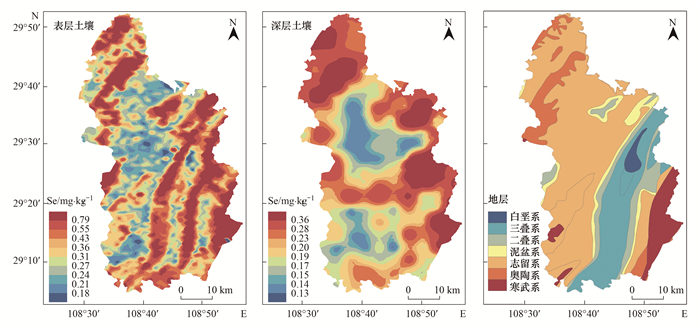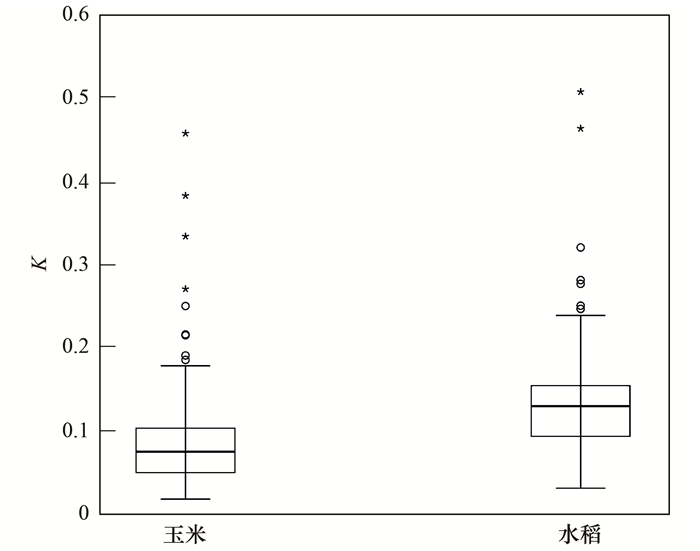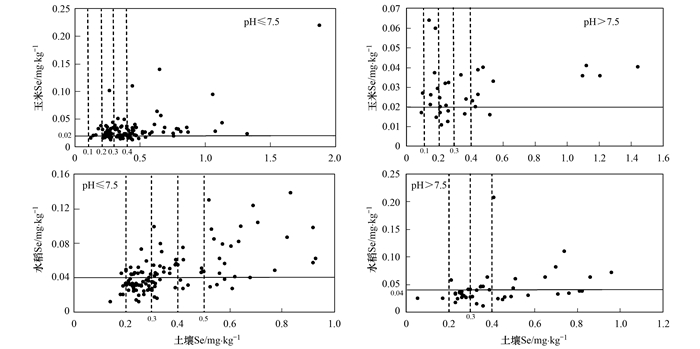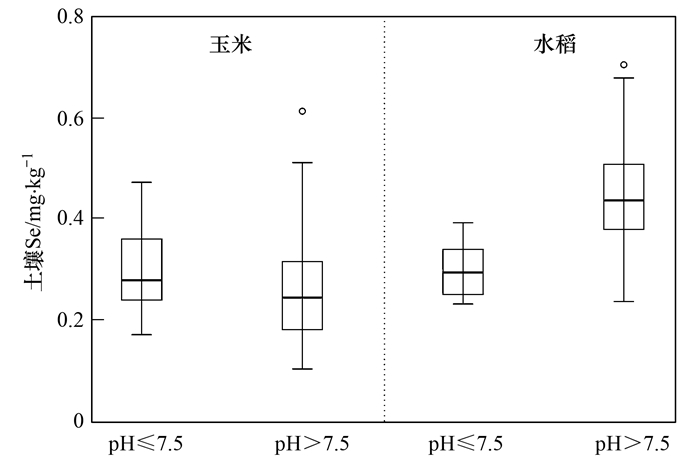2. 重庆市土地质量地质调查重点实验室, 重庆 400038
2. Chongqing Key Laboratory of Land Quality Geological Survey, Chongqing 400038, China
Se位于元素周期表第四周期VI A族, 原子量为78.96[1]. Se是分散的稀有元素, 自然界中Se主要以硒化物的形式作为杂质存在于金属硫化物矿中[2].土壤Se及分布受到成土母质、成土过程、土壤性质等多因素的影响[3]. Se是一种重要的健康元素, 缺乏和过量摄入都会对人体造成危害, Se的缺乏会引起大骨节病、地方性心肌病等疾病, 同时也会对人体的心血管系统造成影响[4~8]. Se会和某些重金属元素发生拮抗反应, 主要表现在Se可以与Cd等重金属元素发生反应, 生成重金属Se蛋白复合物, 该物质不易被人体及动物体吸收[9~12].此外, 重金属会限制生物体内抗氧化酶的生物功能并对生物膜产生破坏, 而Se会减缓重金属的毒害作用, 提高人体及动植物体自身的免疫能力和抗逆性[13].因此, 查明土壤Se的地球化学特征及Se在土壤-农作物中的迁移规律具有重要的意义.
土壤中的Se并不是全部都能被植物吸收利用, 能够被植物直接吸收的形态即为生物有效态, 植物对元素吸收程度即为元素的生物有效性, 而元素的生物有效性受到多种因素的影响, 例如土壤理化性质、土壤组分及农作物种类等[14~16].因此, 进行区域Se资源评价时, 不仅要考虑土壤中Se的含量, 同时应重视不同种类农作物中Se的含量及农作物对土壤Se的吸收程度, 而以往有关富Se土壤的研究均以相应标准给出的富Se土壤阈值进行“一刀切”式的评价, 很少结合农作物Se含量及土壤中其它组分含量进行评价, 这势必会出现一定程度的误判和漏判.已有研究表明, 渝东南地区表层土壤及农作物Se含量丰富, 且分布面积较广, 但并未对富Se资源进行深入研究[17].本文以重庆市黔江区为研究对象, 进行土壤Se来源和分布特征、农作物Se生物有效性及影响因素分析, 并考察基于不同种类的农作物进行土壤富Se阈值研究, 以期为地区富Se土地的划分和富Se资源的有效利用提供理论支撑.
1 材料与方法 1.1 研究区概况黔江区位于重庆市东南地区, 地理坐标为东经108°28′~108°56′, 北纬29°04′~29°52′, 东北和西北与湖北咸丰县和利川市相邻, 南及重庆市酉阳县, 西抵重庆市彭水县, 东西宽45 km、南北长90 km, 总面积为2 402 km2(图 1).黔江区地处四川盆地东南边缘, 山脉河流走向近似平行, 由东北向西南倾斜, 呈“六岭五槽”地貌, 平坝星落其间.山地占全区幅员面积的90%, 东南部山脉条状明显, 切割深; 西北部以低山和浅切割中山为主, 无明显条状带.黔江区地处亚热带, 受山地地形和季风的影响, 形成具有山区变化特征的典型亚热带湿润性季风气候和典型的山区气候, 表现为四季分明, 无霜期长, 降水多, 季节分配不均, 垂直变化明显和局部小气候.多年平均气温15.4℃, 年均降水量1 300 mm, 年均日照1 340 h, 无霜期223~309 d.该区河流较多, 河流流程419 km, 流域面积大于50 km2的有15条, 以八面山为分水岭, 东南为阿蓬江、诸佛江支流, 西北为郁江支流, 均属乌江支系.

|
图 1 研究区交通位置示意 Fig. 1 Map of the traffic locations in the study area |
采用1:50 000比例尺, 采集0~20 cm的表层土壤8 789件.深层样品基本采样密度为每4 km2有1个点, 采集深度约为自地表120~200 cm之间, 深层土壤按16 km2等质量组合成一件分析样品, 共组合深层土壤分析样155件.根据田块特点采用星形法、蛇形法等方法, 采集玉米及根系土样141件, 水稻及根系土159件, 多株农作物或根系土充分混合均匀后, 四分法取样.
土壤样品在自然条件下阴干.在样品干燥过程中要经常揉搓样品, 以免胶结, 并去除土壤中的砾石以及植物根系.干燥后的样品在过筛前用木槌轻轻敲打, 以便使土壤样品恢复至自然粒级状态.样品晾干后用尼龙筛, 截取2 mm(10目)粒级的样品500 g, 装瓶.农作物样品在自然条件下风干, 风干场地需清洁无污染, 将样品风干后脱粒, 利用粉碎机将玉米及水稻籽实磨碎至60目, 并装进自封袋中编号.土壤及农作物样品分析测试由国土资源部成都矿产资源监督检测中心完成.
土壤及农作物样品分析方法及检出限见表 1, 各分析方法的检出限均符合《土地质量地球化学评价规范》(DZ/T 0295-2016)[18]的要求.
|
|
表 1 元素分析方法与检出限1) Table 1 Elemental analysis methods and detection limits |
土壤样品采用分析国家一级标准物质(GSS-4、GSS-5、GSS-7、GSS-8、GSS-9、GSS-12、GSS-18、GSS-20、GSS-21、GSS-22、GSS-23、GSS-24、GSS-26、GSS-27及GSS-29)的方法进行准确度(相对误差, RE检验).随机抽样分析(数量为每批次试样数的20%~30%)进行精密度检验.农作物每一批样品插入同类型标准物质1~2个与样品同时分析, 并计算单个样品单次测试值的相对误差, 要求相对误差≤30%.精密度控制:采用重复分析的方法控制样品分析的精密度, 每件样品进行重复分析, 双份分析的相对双差≤30%.样品分析测试结果符合文献[18]的要求, 数据质量可靠.
1.3 数据处理方法数据整理利用Excel 2010及SPSS 25.0完成, 半方差函数拟合利用GS+9.0完成, 图件绘制利用CorelDRAW18、SPSS 25.0、Excel 2010及ArcGIS10.2完成.
2 结果与讨论 2.1 土壤Se含量统计研究区采集的8789件表层土壤样品及155件深层土壤中Se的含量结果见表 2.表层土壤Se的含量范围为0.02~14.94 mg·kg-1, 平均含量为0.43 mg·kg-1, 变异系数为1.67, 研究区表层土壤及根系土中Se的平均含量低于广西[19, 20]、湖北恩施[21~23]及陕西紫阳[24]等富Se区.深层土壤Se的含量范围为0.09~3.27 mg·kg-1, 平均含量为0.23 mg·kg-1, 变异系数为1.15.表层土壤和深层土壤Se含量的变异系数均较大, 说明其含量在空间上分布不均匀[25].此外, 表层土壤Se含量的平均值是深层土壤Se含量平均值的1.86倍, 表明Se可能出现了表层富集现象.
|
|
表 2 土壤Se含量 Table 2 Soil selenium contents |
表 3为文献[18]给出的土壤Se含量分级标准, 根据该标准, 对研究区表层土壤Se进行分级, 结果见图 2.可以看出, 研究区表层土壤Se处于缺乏、边缘、适量、高及过剩的比例分别为1.97%、7.19%、57.72%、32.72%及0.40%, 说明研究区土壤Se资源较丰富, 具备开发富Se资源的潜力.
|
|
表 3 土壤Se含量分级标准 Table 3 Classification standards of Se contents in soils |

|
图 2 表层土壤Se含量等级统计 Fig. 2 Statistics of topsoil Se content grades |
对表层土壤和深层土壤Se含量进行正态分布检验, 结果见表 4, 可以看出, 表层土壤和深层土壤Se含量的原始数据均不符合正态分布, 经对数变换后, 基本符合正态分布.
|
|
表 4 土壤Se含量正态分布检验 Table 4 Tests for a normal distribution of soil Se contents |
利用GS+9.0软件对经对数变换后的表层和深层土壤Se数据进行半方差函数分析, 结果见表 5.表层和深层土壤Se均为指数函数类型, 块金系数分别为0.139和0.152, 说明土壤Se含量空间自相关性强, 主要受到自然因素的控制[26].
|
|
表 5 土壤Se含量的变异参数 Table 5 Variation of Se contents in soils by parameter |
利用普通克里金法对表层和深层土壤Se含量进行空间插值, 结果见图 3.从中可知, 表层土壤Se含量的高值区呈条带状分布, 空间变异明显, 与深层土壤Se含量分布情况对比发现, 二者高含量区和低含量区的分布格局类似, 此外, 土壤Se含量与地层的分布的空间相似性较高.

|
图 3 土壤Se含量及地层空间分布 Fig. 3 Soil Se contents and stratal spatial distribution |
统计不同地层出露区表层土壤与深层土壤Se的含量, 结果见图 4.不同地层分布区表层土壤Se含量的大小顺序为二叠系(0.99 mg·kg-1)>寒武系(0.88 mg·kg-1)>泥盆系(0.49 mg·kg-1)>奥陶系(0.45 mg·kg-1)>三叠系(0.44 mg·kg-1)>志留系(0.30 mg·kg-1)>白垩系(0.27 mg·kg-1), 深层土壤也是二叠系(0.45 mg·kg-1)和寒武系(0.41 mg·kg-1)地层分布区土壤Se含量较高.调查发现, 研究区二叠系地层主要出露灰岩及含煤页岩, 寒武系地层主要出露灰岩及炭质泥页岩, 含煤黑色岩系由于自身Se含量丰富, 土壤对母岩具有继承性, 使得土壤中Se富集[27, 28].因此, 研究区土壤Se主要受到成土母质的控制, Se源稳定, 可进行长期的富Se土地开发利用.

|
图 4 不同地层分布区土壤Se含量 Fig. 4 Se content of soils in different strata distribution areas |
对同一地层而言, 表层土壤Se含量均高于深层土壤, 进一步证明了土壤Se出现了表层富集现象.表 6为表层土壤Se含量与土壤其他组分含量的相关分析结果.可以看出, 土壤有机质、铁锰、铝及钾的含量均和土壤Se含量呈显著正相关关系.主要原因可能为, 母岩在风化过程中, 可溶性的矿物发生淋溶作用而流失, 使得黏土矿物、铁锰氧化物及有机质在表层富集, 对Se有着较强的吸附螯合作用, 使得Se在表层富集[29].此外, Tim等[30]的研究发现, 湿沉降是土壤中Se的主要来源之一, 研究区降水丰沛, 所以大气沉积也可能造成土壤Se的输入.
|
|
表 6 表层土壤Se含量与土壤组分含量相关关系1) Table 6 Correlation between Se content in surface soil and soil component content |
2.3 农作物Se含量特征
分别统计研究区采集的141件玉米样品及159件水稻样品的Se含量特征, 基于《富硒稻谷》(GB/T 22499-2008)[31]及《富硒农产品》(DB50/T 705-2016)[32]中给出的相应标准, 计算富Se率, 结果见表 7.玉米及水稻Se含量范围分别为0.01~0.22 mg·kg-1和0.01~0.21 mg·kg-1, 平均值分别为0.03 mg·kg-1和0.05 mg·kg-1, 富Se率分别为75.35%和46.81%, 农作物Se含量丰富.
|
|
表 7 农作物Se含量及富Se率 Table 7 Se contents and Se-rich ratios of crops |
2.4 Se生物有效性
元素富集系数是指农作物样品中元素含量与根系土中对应元素含量的比值, 可反映作物对土壤中元素的吸收富集能力及元素的生物有效性, 计算式如下[19]:

|
(1) |
式中, K表示元素的富集系数; Ccrop为Se在作物中的含量, 单位为mg·kg-1; Csoil为Se元素在根系土中的含量, 单位为mg·kg-1.
利用式(1)分别计算玉米和水稻对土壤Se的富集系数, 结果见图 5.玉米、水稻Se富集系数的变化范围分别为0.02~0.46和0.03~0.51, 平均值分别为0.09和0.13.

|
图 5 农作物Se富集系数K Fig. 5 Coefficients of Se enrichment in crops |
利用SPSS进行多元回归分析, 得到农作物吸收模型, 结果见表 8, 玉米和水稻元素吸收模型的R值分别为0.606、0.692, NME均小于0, 说明模型拟合低估了实际值, NRMSE均较低[19], 说明模型拟合效果较好.
|
|
表 8 农作物Se吸收模型 Table 8 Models of crop Se absorption |
可以看出, 土壤有机质含量与富集系数K呈负相关关系, 即土壤中的有机质会导致植物对Se的富集能力减弱, 主要原因为, 土壤有机质对Se具有吸附和配位反应能力, 对土壤Se具有固定作用, 在土壤中易与Se形成螯合物, 抑制了植物对Se的吸收[33, 34]. Se是典型的亲S元素, 无论在土壤还是在动植物体中, 都存在普遍的Se和S的相互作用.植物对Se的吸收是通过硫酸盐转运的, 相关研究表明, S对Se生物有效性的影响是双向的, 在土壤硫含量较低时, 硒酸盐与硫酸盐表现为协同作用, 土壤硫含量较高时, 硒酸盐与硫酸盐则表现为拮抗作用, 主要原因为, 在土壤S和Se的浓度较高时, SO42-比SeO42-先进入植物体内, 进而抑制植物对SeO42-的吸收, 而在土壤S和Se浓度较低时, SO42-和SeO42-同时进入植物体内, 表现为协同作用[35, 36], 研究区土壤中Se含量丰富, 因此S和Se表现为拮抗作用.可见, 农作物Se含量不仅受到土壤Se含量的影响, 也会受到土壤其他组分含量的影响, 因此, 富Se土壤的评价应充分考虑农作物及土壤中元素的含量特征, 仅以土壤Se含量进行富Se土壤评价往往会存在误差.
2.5 富硒土壤阈值划分以富Se农作物标准为基础, 在既定土壤富Se阈值下, 土壤富Se且农作物富Se以及土壤不富Se且农作物不富Se的区域即为正确区, 土壤不富Se但农作物富Se的区域即为遗漏区, 土壤富Se但农作物不富Se的区域即为误判区.按照《天然富硒土地划定与标识》(DD 2019-10)[37]给出的一般富Se土壤的标准为基础值(当pH≤7.5时, 富Se土壤阈值为0.4 mg·kg-1; 当pH>7.5时, 富Se土壤阈值为0.3 mg·kg-1)、文献[31, 32]给出的富Se农作物标准(水稻0.04 mg·kg-1, 玉米0.02 mg·kg-1), 进行研究区富Se阈值的划分, 结果见图 6(实线代表富Se农作物标准, 虚线代表土壤富Se阈值)和表 9.可以看出, 以文献[37]给出的富Se土壤阈值进行判断时, 存在明显的误判和遗漏, 对富Se土壤阈值进行适当调整, 正确率出现了一定的提高, 例如, 当pH≤7.5时, 以0.1 mg·kg-1作为玉米富Se阈值, 其正确率为76.1%, 明显高于以0.4 mg·kg-1作为阈值时的判定结果, 但是, 随着正确率的提高, 误判率也不断提高, 因此, 不能以正确率作为唯一判定标准.

|
图 6 富Se土壤阈值 Fig. 6 Se-rich soil threshold |
|
|
表 9 富Se土壤阈值统计结果 Table 9 Statistical results of Se-rich soil threshold |
利用表 8给出的元素吸收模型、根系土壤测试数据及富Se农作物标准, 反推计算土壤的富Se阈值, 结果见图 7.玉米数据计算结果显示, 当土壤pH≤7.5时, 土壤Se含量范围为0.14~0.49 mg·kg-1, 平均含量为0.29 mg·kg-1, 当pH>7.5时, 土壤Se含量范围为0.10~0.61 mg·kg-1, 平均含量为0.26 mg·kg-1.水稻数据计算结果显示, 当土壤pH≤7.5时, 土壤Se含量范围为0.21~0.40 mg·kg-1, 平均含量为0.33 mg·kg-1, 当pH>7.5时, 土壤Se含量范围为0.20~0.70 mg·kg-1, 平均含量为0.42 mg·kg-1.

|
图 7 富Se土壤阈值计算结果 Fig. 7 Calculated results of Se-rich soil threshold |
结合表 9的统计结果, 给出如下建议:若种植作物为玉米, 无论土壤呈中酸性还是碱性, 均以0.3 mg·kg-1作为富Se土壤阈值, 虽然取该值时, 正确率并非最高, 但误判率相对较低.若种植作物为水稻, 在土壤pH≤7.5时, 以0.3 mg·kg-1作为富Se土壤阈值, 若取0.4 mg·kg-1时, 虽然误判率较低, 但遗漏率偏高; 在土壤pH>7.5时, 以0.4 mg·kg-1作为富Se土壤阈值.同样地, 若研究区种植有其他大宗农作物, 亦建议用该方法进行富Se土壤阈值的划分.由于研究区大宗农作物Se含量超过相应Se限值的样本较少, 因此, 本研究未给出土壤Se的限量.
3 结论(1) 研究区采集的土壤Se含量统计结果显示, 表层和深层土壤中Se含量的平均值分别为0.43 mg·kg-1和0.23 mg·kg-1, 变异系数分别为1.67和1.15, 空间分布不均匀; 土壤地球化学等级划分结果显示, 表层土壤Se含量处于适量和高的比例分别占全区的57.72%和32.72%, 土壤Se资源丰富.
(2) 半方差函数分析结果显示, 表层和深层土壤Se均为指数函数类型, 块金系数分别为0.139和0.152, 说明土壤Se含量空间自相关性强.二叠系和寒武系地层出露区表层及深层土壤Se含量均较高, 这与二叠系及寒武系出露的黑色岩系及灰岩有关, 说明研究区土壤Se主要来源于成土母质, 土壤Se源稳定, 适于长期开发富Se资源.表层土壤Se富集现象明显, 主要和土壤中有机质、铁锰氧化物及黏土矿物有关.
(3) 玉米及水稻Se含量的平均值分别为0.03 mg·kg-1和0.05 mg·kg-1, 富Se率分别为75.35%和46.81%, 农作物Se含量丰富.玉米及水稻Se吸收模型显示, 研究区农作物硒生物有效性主要受控于土壤有机质及S含量, 土壤有机质和S均会抑制植物对Se的吸收.
(4) 若种植作物为玉米, 无论土壤呈中酸性还是碱性, 均以0.3 mg·kg-1作为富Se土壤阈值.若种植作物为水稻, 在土壤pH≤7.5时, 以0.3 mg·kg-1作为富Se土壤阈值; 在土壤pH>7.5时, 以0.4 mg·kg-1作为富Se土壤阈值.同样地, 若研究区种植有其他大宗农作物, 亦可用该方法进行富Se土壤阈值的划分.
| [1] |
王锐, 余涛, 曾庆良, 等. 我国主要农耕区土壤硒含量分布特征、来源及影响因素[J]. 生物技术进展, 2017, 7(5): 359-366. Wang R, Yu T, Zeng Q L, et al. Distribution characteristics, origin and influencing factors of soil selenium concentration of main farming areas in China[J]. Current Biotechnology, 2017, 7(5): 359-366. |
| [2] | Bañuelos G S, Arroyo I, Pickering I J, et al. Selenium biofortification of broccoli and carrots grown in soil amended with Se-enriched hyperaccumulator Stanleya pinnata[J]. Food Chemistry, 2015, 166: 603-608. DOI:10.1016/j.foodchem.2014.06.071 |
| [3] |
余涛, 杨忠芳, 王锐, 等. 恩施典型富硒区土壤硒与其他元素组合特征及来源分析[J]. 土壤, 2018, 50(6): 1119-1125. Yu T, Yang Z F, Wang R, et al. Characteristics and sources of soil selenium and other elements in typical high selenium soil area of Enshi[J]. Soils, 2018, 50(6): 1119-1125. |
| [4] | Girling C A. Selenium in agriculture and the environment[J]. Agriculture, Ecosystems & Environment, 1984, 11(1): 37-65. |
| [5] | Long Z D, Yuan L X, Hou Y Z, et al. Spatial variations in soil selenium and residential dietary selenium intake in a selenium-rich county, Shitai, Anhui, China[J]. Journal of Trace Elements in Medicine and Biology, 2018, 50: 111-116. DOI:10.1016/j.jtemb.2018.06.019 |
| [6] | Rayman M P. The importance of selenium to human health[J]. The Lancet, 2000, 356(9225): 233-241. DOI:10.1016/S0140-6736(00)02490-9 |
| [7] |
李继云, 任尚学, 陈代中. 陕西省环境中的硒与大骨节病关系的研究[J]. 环境科学学报, 1982, 2(2): 91-101. Li J Y, Ren S X, Chen D Z. A study of Kaschi-beck disease associated with environmental Seleniumin Shanxi area[J]. Acta Scientiae Circumstantiae, 1982, 2(2): 91-101. |
| [8] | 杨詠元, 杜宝珍. 陕西省环境中硒与克山病的发病关系[J]. 中国环境科学, 1983, 4(2): 53-55. |
| [9] | Sieprawska A, Kornas A, Filek M. Involvement of selenium in protective mechanisms of plants under environmental stress conditions-review[J]. Acta Biologica Cracoviensia. Series Botanica, 2015, 57(1): 9-20. DOI:10.1515/abcsb-2015-0014 |
| [10] | Filek M, Zembala M, Hartikainen H, et al. Changes in wheat plastid membrane properties induced by cadmium and selenium in presence/absence of 2, 4-dichlorophenoxyacetic acid[J]. Plant Cell, Tissue and Organ Culture, 2009, 96(1): 19-28. DOI:10.1007/s11240-008-9455-0 |
| [11] | Hartikainen P, Soininen H, Reinikainen K J, et al. Neurotransmitter markers in the cerebrospinal fluid of normal subjects Effects of aging and other confounding factors[J]. Journal of Neural Transmission/General Section JNT, 1991, 84(1-2): 103-117. DOI:10.1007/BF01249114 |
| [12] |
蔡黎新, 蔡碧忍. 硒镉摄入对大鼠脏器中硒、镉、铜、锌、锰含量的影响[J]. 中国公共卫生, 2001, 17(10): 893-894. Cai L X, Cai B R. Effect of Selenium, cadmium supplement on contents of Se、Cd、Cu、Zn、Mn in rat organ[J]. China Publichealth, 2001, 17(10): 893-894. |
| [13] | Parker D R, Feist L J, Varvel T W, et al. Selenium phytoremediation potential of Stanleya pinnata[J]. Plant and Soil, 2003, 249(1): 157-165. DOI:10.1023/A:1022545629940 |
| [14] | Peng Q, Li J, Wang D, et al. Effects of ageing on bioavailability of selenium in soils assessed by diffusive gradients in thin-films and sequential extraction[J]. Plant and Soil, 2019, 436(1-2): 159-171. DOI:10.1007/s11104-018-03920-y |
| [15] | Wang M K, Cui Z W, Xue M Y, et al. Assessing the uptake of selenium from naturally enriched soils by maize (Zea mays L.) using diffusive gradients in thin-films technique (DGT) and traditional extractions[J]. Science of the Total Environment, 2019, 689: 1-9. DOI:10.1016/j.scitotenv.2019.06.346 |
| [16] | Jia M M, Zhang Y X, Huang B, et al. Source apportionment of selenium and influence factors on its bioavailability in intensively managed greenhouse soil: a case study in the east bank of the Dianchi Lake, China[J]. Ecotoxicology and Environmental Safety, 2019, 170: 238-245. DOI:10.1016/j.ecoenv.2018.11.133 |
| [17] |
曾琴琴, 王永华, 刘才泽, 等. 秀山-酉阳地区土壤环境地球化学特征[J]. 四川地质学报, 2019, 39(2): 294-298. Zeng Q Q, Wang Y H, Liu C Z, et al. Pedogeochemistry in the Xiushan-Youyang region[J]. Acta Geologica Sichuan, 2019, 39(2): 294-298. |
| [18] | DZ/T 0295-2016, 土地质量地球化学评价规范[S]. |
| [19] | Gu Q B, Yang Z F, Yu T, et al. Application of ecogeochemical prediction model to safely exploit seleniferous soil[J]. Ecotoxicology and Environmental Safety, 2019, 177: 133-139. DOI:10.1016/j.ecoenv.2019.03.084 |
| [20] | Gu Q B, Yu T, Yang Z F, et al. Prediction and risk assessment of five heavy metals in maize and peanut: a case study of Guangxi, China[J]. Environmental Toxicology and Pharmacology, 2019, 70: 103199. DOI:10.1016/j.etap.2019.103199 |
| [21] |
王锐, 余涛, 杨忠芳, 等. 富硒土壤硒生物有效性及影响因素研究[J]. 长江流域资源与环境, 2018, 27(7): 1647-1654. Wang R, Yu T, Yang Z F, et al. Bioavailability of soil selenium and Its influencing factors in selenium-enriched soil[J]. Resources and Environment in the Yangtze Basin, 2018, 27(7): 1647-1654. |
| [22] |
曾庆良, 余涛, 王锐. 土壤硒含量影响因素及富硒土地资源区划研究——以湖北恩施沙地为例[J]. 现代地质, 2018, 32(1): 105-112. Zeng Q L, Yu T, Wang R. The influencing factors of selenium in soils and classifying the selenium-rich soil resources in the typical area of Enshi, Hubei[J]. Geoscience, 2018, 32(1): 105-112. |
| [23] |
张光弟, 葛晓立, 张绮玲, 等. 湖北恩施硒中毒区土壤硒的分布及其控制因素[J]. 中国地质, 2001, 28(9): 37-40, 36. Zhang G D, Ge X L, Zhang Q L, et al. Distribution of selenium in soil of the Enshi selenium intoxication area Hubei and its constraints[J]. Chinese Geology, 2001, 28(9): 37-40, 36. |
| [24] | Zhang Y, Wu S Y, Zheng H, et al. Modes of selenium occurrence and LCD modeling of selenite desorption/adsorption in soils around the selenium-rich core, Ziyang County, China[J]. Environmental Science and Pollution Research, 2018, 25(15): 14521-14531. DOI:10.1007/s11356-018-1595-0 |
| [25] |
柳云龙, 章立佳, 韩晓非, 等. 上海城市样带土壤重金属空间变异特征及污染评价[J]. 环境科学, 2012, 33(2): 599-605. Liu Y L, Zhang L J, Han X F, et al. Spatial variability and evaluation of soil heavy metal contamination in the urban-transect of Shanghai[J]. Environmental Science, 2012, 33(2): 599-605. |
| [26] | Cambardella C A, Moorman T B, Novak J M, et al. Field-scale variability of soil properties in central Iowa soils[J]. Soil Science Society of America Journal, 1994, 58(5): 1501-1511. DOI:10.2136/sssaj1994.03615995005800050033x |
| [27] |
张靖源, 陈剑平, 黄邵华, 等. 广西鹿寨水稻及其种植土壤中硒含量分布特征分析[J]. 南方农业学报, 2016, 47(11): 1856-1860. Zhang J Y, Chen J P, Huang S H, et al. Distribution characteristics of selenium content in rice and rhizosphere soil in Luzhai, Guangxi[J]. Journal of Southern Agriculture, 2016, 47(11): 1856-1860. |
| [28] | Forduce F M, Zhang G D, Green K, et al. Soil, grain and water chemistry in relation to human selenium-responsive diseases in Enshi District, China[J]. Applied Geochemistry, 2000, 15(1): 117-132. |
| [29] | Zhu J M, Zheng B S. Distribution of selenium in a mini-landscape of Yutangba, Enshi, Hubei Province, China[J]. Applied Geochemistry, 2001, 16(11-12): 1333-1344. DOI:10.1016/S0883-2927(01)00047-6 |
| [30] | Blazina T, Sun Y B, Voegelin A, et al. Terrestrial selenium distribution in China is potentially linked to monsoonal climate[J]. Nature Communications, 2014, 5: 4717. DOI:10.1038/ncomms5717 |
| [31] | GB/T 22499-2008, 富硒稻谷[S]. |
| [32] | DB50/T 705-2016, 富硒农产品[S]. |
| [33] | Wang Q Y, Zhang J B, Zhao B Z, et al. Influence of long-term fertilization on selenium accumulation in soil and uptake by crops[J]. Pedosphere, 2016, 26(1): 120-129. DOI:10.1016/S1002-0160(15)60028-5 |
| [34] | Xiao K C, Tang J J, Chen H, et al. Impact of land use/land cover change on the topsoil selenium concentration and its potential bioavailability in a karst area of southwest China[J]. Science of the Total Environment, 2020, 708: 135201. DOI:10.1016/j.scitotenv.2019.135201 |
| [35] | Di Tullo P, Pannier F, Thiry Y, et al. Field study of time-dependent selenium partitioning in soils using isotopically enriched stable selenite tracer[J]. Science of the Total Environment, 2016, 562: 280-288. DOI:10.1016/j.scitotenv.2016.03.207 |
| [36] | Shand C A, Eriksson J, Dahlin A S, et al. Selenium concentrations in national inventory soils from Scotland and Sweden and their relationship with geochemical factors[J]. Journal of Geochemical Exploration, 2012, 121: 4-14. DOI:10.1016/j.gexplo.2012.06.001 |
| [37] | DD 2019-10, 天然富硒土地划定与标识[S]. |
 2020, Vol. 41
2020, Vol. 41


